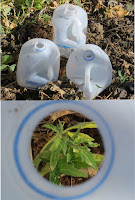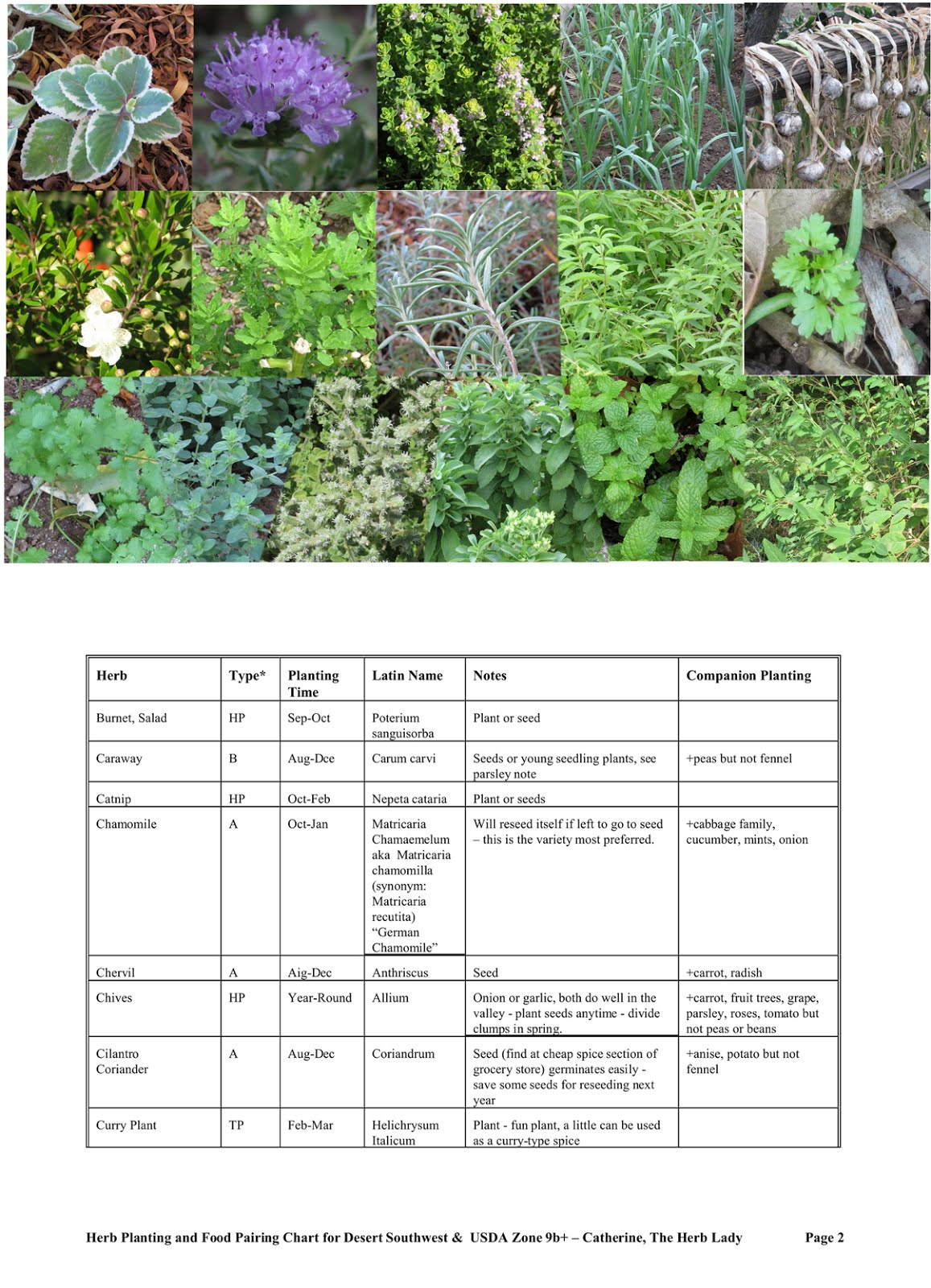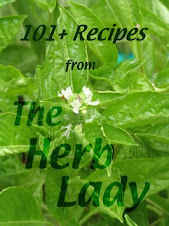March is a month which confounds and surprises. The old adage of coming in like a lion and leaving like a lamb is actually flipped for the desert southwest garden. We can start out with Mid-40 degree nights (sometimes down into the 30s) and a nice 70s day time temp, and leap to the mid-90s day time by the end of the month. "The record for the earliest first 100-degree day is March 26, 1988." I use to log the daily highs and lows myself.
[Our "Katy" Apricot - bud to flower in 3 days.]
There Is Still Time To Register for the "LEAP into Lavender" event this Saturday.
We usually "leap" over what some would call spring and right into warm. When I met some new friends many years ago who had moved here from the east coast, he asked when spring was - it was late March. I said, remember about 2 weeks ago or so when it was in the high 70s and low 80s - he said yes, and I said that was it.
Oh, and we can get a one-frost and even hail!
I transplanted my tomato seedlings started December 10th on February 7th. Because we can still have possibility of near freezing for at least several week, and, as I mentioned hail, I am using these Poor-Man's Cloches to protect them. With the cap in place, I can leave them on for several weeks and the cap-off vents heat build up. [Close up is seedling down in the jug.]
This means you really need to pay attention to the moisture in the soil, using mulch to keep the soil surface cool and consider density of planting. You can add flowers around new seedlings or transplants (see my flower mulching technique below).
MARCH PLANTING:
Artichoke, Jerusalem
Artichoke, Globe
Basil, Plant or seed
Bay, Greek aka Sweet
Bean, Lima
Beans, Snap
Beans, Soy (March 15th)
Bee Balm
Beets
Cantaloupe
Carrots
Catnip, Plant or Seed
Chives, Garlic, Plant or seed
Chives, Onion, Plant or seed
Corn
Cucumbers
Eggplant
English Daisy
Epazote, Plant or seed
Hollyhock
Jicama
Lavender
Lemon Grass
Lemon Balm
Lemon Verbena
Marigolds including ,Citrus Scented (Tagetes Nelsonii), Tangerine Scented (Tagetes Lemonii)
Marjoram
Melons, Winter
Melons, Musk
Mints
Myrtle
Okra
Onions, Green
Oregano, Mexican
Oregano, Greek
Peppers
Perilla, Plant or Seed
Portulaca
Pumpkin
Radishes
Rosemary
Safflower
Sage
Savory
Scented Geraniums
Squash, Winter
Stevia
Summer Squash
Sunflower
Sweet Alyssum
Tarragon, Mexican
Tarragon, French
Thyme
Tomatillo
Tomatoes
Watermelon
GARDEN TIPS for March
If you are just now thinking about planting, see Flower Mulching technique. And run, do not walk, to purchase a water meter from your favorite garden nursery. The gallop into high heat can occur this month with such rapidity that we can go 70 to 95 in 30 days.
[A little funny ladybug cartoon from the internet.]

Get a jump on spring with weed cleanup. Some pests breed on the winter weeds and can launch an incredible attack (a type of gnat can assume locus swarm proportions), which may cover everything light or white in color, plants, flowers, buildings, even clothes drying on the line.
Perennial herbs will be starting to flower by end of March / beginning of April. If you use thyme, marjoram, oregano or any of the trailing herbs as ground covers, enjoy the blooms, then give them a hair cut. Remember the flowers are edible!
HAIL!!! Is a possibility in spring as the soil warms, and weather highs and lows bring alternating warm and cool air mass. If you add winds to the mix HAIL is a strong possibility. Keep your frost protection covers/poor man’s cloches handy.
The pest bugs like our mild weather too with aphids a particular pest. SAFE Soap Spray for aphids: 1 tsp each vegetable oil and Dawn to 1 quart of water. Spray every 5 days at sunset at least 3 times. DO NOT MISS a follow up spraying - spraying once will not take care of the aphid problem. The 1st gets the active adults, the 2nd one picks up the just hatched and missed ones, and 3rd one gets the stragglers. Try NOT to spray the good bugs as the spray can harm them too.
FLOWER MULCHING TECHNIQUE
Some years ago I tripped across this idea when I wanted to grow a lot of basil fast, and I was planting late into the heat (late spring, early summer).
First, what is going on that a special technique needs to be used?
As the spring and summer day time temperatures climb into the high 90s and 100s, the surface of ANYTHING heats up and stays hot -- remember burning your feet on the pool surrounds? By July and August the surface afternoon mean temperature of soil, the sides of pots, asphalt and concrete can be as high as 180 degrees F! That includes the top 3-4 inches of soil. Without a protective canopy or surround the soil heats up to root killing levels.
So back to the basil. It was June and as I say I wanted a lot of basil fast, and so I planted about 8 young starter basil plants out of 3-4 inch containers, planting them about 6 inches apart. As I watched them over the course of a couple of weeks, the outer plants one by one died off. But the 1 or 2 plants in the center not only lasted, they thrived.
So what was going on? The outer plantings shaded the sides of the center plants, but still allowed the very necessary direct sunlight from above to feed (photosynthesis) the center plants. The outer plants leaves, while canopying the soil around the center plants also keep the soil surface cooler and moister until the center plants grew big enough to be their own canopies.
My "Flower Mulching" technique was born. Not wanting to sacrifice primary edibles, I turned to seasonal edible flowers to provide the initial protection.
THE TECHNIQUE: Imagine a 12 inch diameter circle. Place your primary herb, vegetable or fruit plant in the middle and using 3-5 flowers from a six pack or 3-5 4 inch flowers plant very close to the primary plant staying within the imaginary 12 inches. You can also plant the flowers first and then the primary plant, or you can use existing plantings to perform the same service. Many of the flowers will survive to be used in salads etc. (which is why I choose seasonal edible flowers). If the flower plants were not grown organically or without chemicals, wait 90 days before harvesting the flowers for food use.
If you want my planting tips at your finger tips, see my website for calendars and books. There are also links on the sidebar here on the blog.
Enjoy your garden and its bounty.
-- Catherine, The Herb Lady
If you enjoyed this post, please share and subscribe below by entering your email, to get all my posts!
Disclaimer: Clicking on links on this blog may earn me a small commission if you purchase something. Your price does not change.
























No comments:
Post a Comment